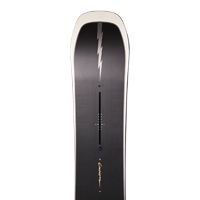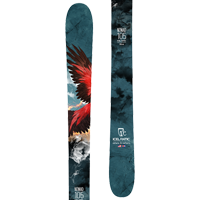Arguably the most important part of your snowboard gear, snowboard boots can make or break your day on the mountain. Snowboard boots must fit comfortably, correctly, and work well with your bindings. Don’t skimp here; snowboard boots are where it pays to spend a little more money and time getting the right fit. Let’s begin with the most important distinctions and characteristics to consider when buying snowboard boots:
Fit
Snowboard boots should fit snugly, but not to the point where they cause pain. Most boots need several days of riding for them to pack out and form to their true size, and as a result should be fairly tight when brand new.
In a good fitting boot your toes will gently graze the boot’s toecap and you should be able to wiggle your toes inside the boots. Heel hold is another important factor. When your knee is driven forward your heel should remain in place; this is important for board control in toeside turns. Remember that socks also play a part in boot fit - a single thin to medium weight wool or synthetic sock is all you need. There is a fine line between a boot that is too tight or uncomfortable and one that is too loose and gives heel lift.
Click here to view a full snowboard boot size chart
Boot Flex
Snowboard boots have different flex ratings, ranging from soft to stiff. Boot flex is a personal preference but generally a softer flex is chosen by park and beginner riders. For advanced, all mountain riders and freeriders, a stiffer flexing boot is often favored. Boot flex ratings are not necessarily standardized from one manufacturer to the next, so flex may vary from brand to brand. Many manufacturers will give a number rating ranging from 1-10, 1 being softest and 10 being stiffest. We rate stiffness as a "feel" rating ranging from soft to very stiff. Generally we class manufacturers' ratings of 1-2 as soft, 3-5 as medium, 6-8 as stiff, and 9-10 as very stiff. Flex ratings and feel may vary from boot to boot.
Lacing Systems
Traditional Lacing
Traditional laces are the tried and true option for your prototypical rider. By tightening your boots by hand, traditional laces offer the most customizable fit among the different lacing styles. Although easy to use, traditional laces can be difficult on your hands in harsh winter weather and can often loosen during the day. Despite this, many snowboarders stick with this classic system for easy lace replacement and a tailor-made fit.
Quick-Pull Lacing
Faster than traditional laceing systems. Many quick-pull lacing system allow the forefoot and ankle/lower leg to tighten indepentendly from each other, this is called zonal lacing. This type of lacing system is fast, easy, and can be tightened while wearing gloves. There are many different types of quick-pull lacing sysems that cary from manufacturer to manufacturer
BOA® Lacing
Boa® lacing systems offer fast and easy micro adjustability to your boot fit. Boa® systems use a ratcheting dial attached to a cable. The turning and locking can be done with one hand and also with gloves on. Boa® closures are often offered as a double or even triple system, with one dial controlling the forefoot tightness and one or two controlling the upper cuff tightness.
TYPES OF BOA® LACING SYSTEMS
|
Boa® Coiler |
Central, fast Boa® on the boot tongue |
|
Double Boa® |
Boa® at the sides of the boot for upper and lower zone tightening |
|
Triple Boa® |
2 external for upper and lower zone tightening and a third reel adjusts the liner |
Hybrid systems combine two of the three systems into one boot, often with the combination of traditional or quick-pull lacing for the liner and Boa® for the exterior.
Liners
A liner is the inner boot within the snowboard boot and is most commonly made of a lightweight, moldable material called EVA (Ethylene Vinyl Acetate). The liner is an important aspect of the boot construction because it provides the cushioning, stability and insulation you need to ensure comfortable feet on the mountain after long days of ripping. Some liners are removable, while others are permanently attached to the boot. Removable liners can be taken out for speed drying when they get wet.
TYPES OF LINERS
|
Stock Liners |
Provide base-level padding and stability and over time will conform to your foot’s shape. |
|
Moldable Liners |
A step up from stock in price and materials; they are built to mold to your foot shape overtime through body heat. |
|
Heat-Moldable Liners |
A premium in the boot world that provides a true custom fit for your feet. |
Footbeds
Orthopedic footbeds or insoles can be used to increase your foot’s comfort level in your snowboard boots. To choose a proper footbed for both your foot shape and boot, see a bootfitter.
Sizing
Snowboard boots use traditional US number sizing, but actual boot sizes can vary by manufacturer and even by model within a single manufacturer's line. For example, the outsole of manufacturer A's size 11 might be slightly longer than the outsole of manufacturer B's size 11. Similarly, there are some boots specifically built with a low profile. The shorter outsoles of a low profile boot allows a rider to use a narrower snowboard. Additionally, the ramp angle on snowboard bindings also partially determines how large of a boot you can put on a particular snowboard.
When it comes to compatibility with your snowboard, the size of your boot is important to take into consideration. People with larger (11.5+) and smaller (<7) boot sizes should purchase wider and narrower boards, respectively.
SNOWBOARD WIDTH AND BOOT SIZE CHART
|
Boot Size (US Men’s) |
<8 |
8 - 10 |
10 - 11.5 |
11.5+ |
|
Width (mm) |
<245 |
246 - 254 |
255 - 259 |
260+ |
|
Snowboard Width |
Narrow |
Regular |
Mid-Wide |
Wide |
Socks
Although they may seem trivial, your choice of snowboard socks can make a big difference in comfort and performance. Snowboard specific socks, made of synthetic materials and/or merino wool that keep you warm and wick moisture away should be standard. Along with synthetic sock materials like polypropylene, wool is an excellent insulator, keeping your feet extremely dry and warm. Cotton socks should be avoided since they don't wick moisture away from your feet, and damp feet = cold feet. Thicker socks and wearing 2 pairs of socks places additional material between you and your board and reduces your feel for the snow - the thick outer shell of the boot and the foam inside normally provides plenty of insulation.







